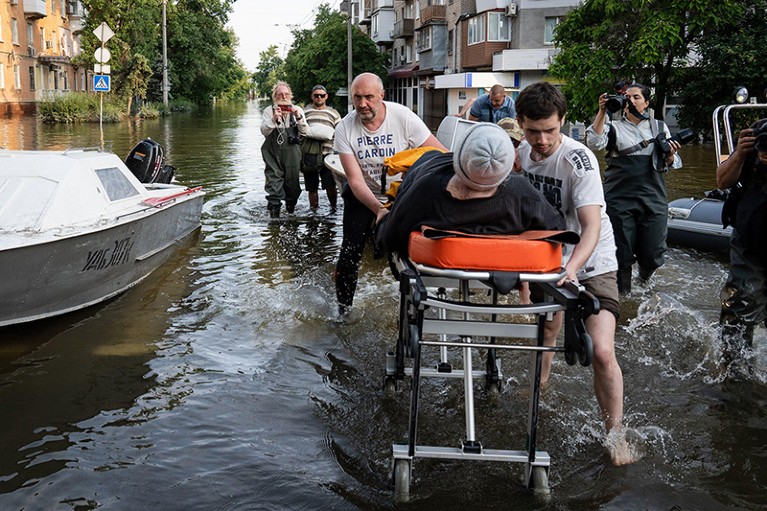
Many people had to be evacuated following flooding caused by the destruction of the Kakhovka dam in Ukraine.Credit: ZUMA Press, Inc./Alamy Stock Photo
Oleksandra Shumilova was hundreds of kilometres away from her native Ukraine when, in early 2022, Russian troops invaded and destroyed a water pipeline near her hometown of Mykolaiv. For 24 days, the taps ran dry. When the water finally returned it was contaminated with salt and harmful chemical deposits that rendered it unsafe for drinking.
The incident struck a chord with Shumilova, a freshwater ecologist at the Leibniz Institute of Freshwater Ecology and Inland Fisheries in Berlin — on multiple levels. Not only was Mykolaiv her hometown, but she studies the floodplains of a river in Italy that still bear the scars of the First World War.
Pockmarked by craters from decades-old aerial bombardments, the area around the Italian river is scattered with unexploded military ordnance. When discovered, these munitions must undergo controlled detonations, creating blasts that reverberate in Shumilova’s mind during her fieldwork.
“Remnants of war can stay in nature for a long time,” Shumilova says. Now, she fears, history is repeating itself in the Russia–Ukraine war.
Shumilova took it upon herself to chronicle what is happening in Ukraine. “This research is very personal,” she says. She began poring over government records and media reports, meticulously searching for instances of damage to water resources and infrastructure, resulting from military actions. She and her collaborators cross-checked their findings with information from a diverse array of Ukrainian, Russian and international sources.

Parts of Kherson, Ukraine, were flooded after the Kakhovka dam was destroyed during the Russia–Ukraine war.Credit: Roman Pilipey/Getty Images
Focusing on just the first three months of the conflict, a detailed record of 64 events emerged, each affecting crucial water facilities and often triggering a chain of events1. Missiles striking hydropower dams, for example, might result in power outages that render water-pumping stations and wastewater treatment facilities inoperable — with devastating consequences. Millions of people can be left without access to clean water, agricultural fields might have insufficient irrigation, and the unchecked flow of untreated sewage and contaminated ground water from industrial mines can pollute nearby river basins, causing significant harm to both people and the environment.
These incidents highlight just one aspect of the intricate interplay between water and armed conflicts. Water resources can be casualties of violence, but disputes over water control can also act as triggers for unrest — for example, when two communities clash over access to a single water source. Furthermore, water is frequently weaponized, as has happened in Gaza, when Israel responded to the deadly attacks by Hamas on 7 October by restricting access to fresh water and cutting off fuel shipments needed to run desalination and water-treatment plants for local production of potable water.
Historical records show that conflicts over water access stretch back millennia, with water systems often being targeted or manipulated as strategic assets on the battlefield. But this water–war nexus seems to be intensifying. Driven by escalating tensions and intensified hostilities in places such as the Middle East, Ukraine, southern Asia and the Sahel region of sub-Saharan Africa, water resources have increasingly become targets or triggers of violence over the past decade, notes environmental scientist Morgan Shimabuku.
“What we do see right now is a really large increase in the total number of water-related conflicts around the globe,” says Shimabuku who is at the non-profit organization the Pacific Institute in Oakland, California, and helped to develop an online database of water-related clashes called the Water Conflict Chronology. There were more than 200 incidents in 2022 alone, and with the ongoing conflicts in Ukraine and Gaza, 2023 is projected to surpass that figure (see ‘Warring over water’).
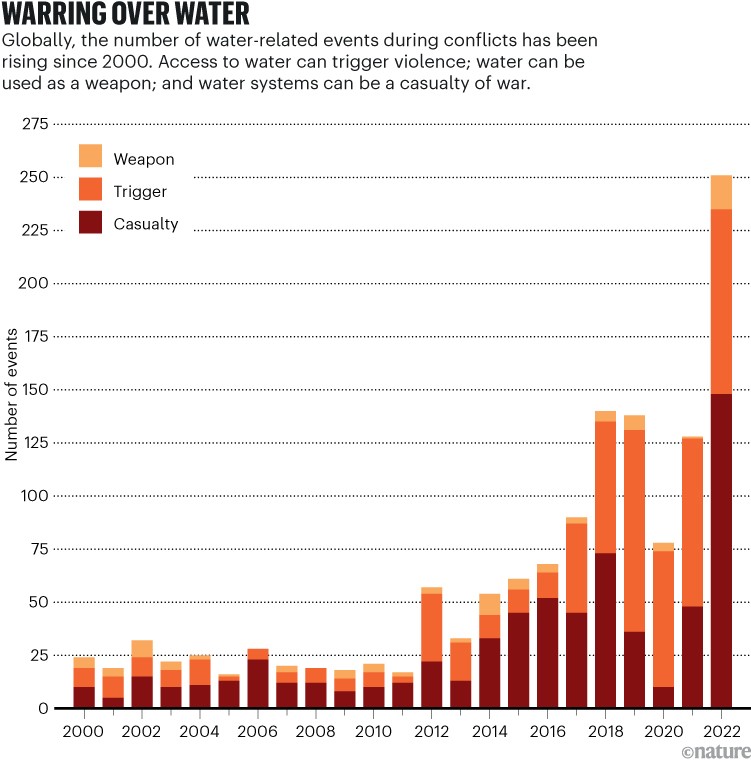
Source: Adapted from O. Shumilova et al. Nature Sustain. 6, 578–586 (2023)
Add in the mounting stresses on water systems from population growth and climate change, and the potential for violence and instability is only expected to grow. Shimabuku thinks that there is an urgent need for comprehensive and cooperative efforts to safeguard water resources and to promote peace, but she also sees reasons to be hopeful.
For example, many previously conflicting factions are embracing collaborative water-sharing treaties, which can de-escalate hostilities. “We have a lot more tools in our toolbox now for addressing these challenges,” Shimabuku points out.
Troubled waters
In 1995, the then-vice-president of the World Bank, Ismail Serageldin, made a dire warning for the years ahead: “Many of the wars in this century were about oil, but wars of the next century will be over water.”

People queue to refill drinking water in Mykolaiv, Ukraine, after Russian forces cut off the pipeline used to supply water.Credit: AP Photo/Emilio Morenatti/Alamy Stock Photo
It’s an oft-repeated idea that persists to this day, cited frequently in discussions about water scarcity and conflict. But according to Jampel Dell’Angelo, who studies governance and disputes over freshwater resources at the Vrije University Amsterdam Institute for Environmental Studies in the Netherlands, “this is a myth”. At least when thinking about conflicts between nations.
In a globalized economy of countries interconnected by trade, including that of agricultural commodities that can be considered a form of virtual water transfer, tensions over cross-border issues of water scarcity are often diffused by forms of interstate cooperation. This typically prevents water from serving as a trigger for major wars, but it doesn’t stop localized violence from arising in water-strapped nations.
In Iraq, for example, large-scale protests over tainted water supplies have been met with strong police crackdowns. Frequent droughts in Somalia have prompted herders to abandon their pastoral lifestyles and join militant groups instead. And neighbouring states in India clash every year over their allocated river waters, with demonstrations that often turn violent.
What’s more, the very conditions that promote interstate water peace can actually exacerbate water-related instability at the local level. This is particularly evident in water-scarce low-income countries, which frequently export their limited natural resources, amplifying their local water challenges and potentially fuelling smaller-scale conflicts. “There’s a shift in the burden of water scarcity on the heads of people who already suffer from the lack of water,” Dell’Angelo says.
Further compounding the problem, foreign agribusiness investors have increasingly acquired vast land holdings in low- and middle-income countries, often at the expense of local communities and appropriating valuable water resources in the process. Termed land or water grabbing, this phenomenon gained momentum after the economic and food crises of 2008 — and, according to Dell’Angelo, the ongoing war in Ukraine is likely to further intensify this trend, owing to reductions in Ukrainian grain exports and heightened concerns about food security. “This will put additional pressure on land and water,” Dell’Angelo says, “with escalating consequences.”
One priority of water-security researchers is to prevent similar crises in the future. “We want to put points on a map and show people where water conflict is happening so that we can better apply solutions,” says Samantha Kuzma, a data scientist at the World Resources Institute, an environmental policy and research group in Washington DC.
Those efforts begin with prediction. To identify problem hotspots, Kuzma and her colleagues developed an artificial intelligence algorithm called the Global Early Warning Tool. This tool considers a wide range of environmental, economic and social factors. By comparing past trends to present data, it flags regions where water-related issues such as flooding, pollution and scarcity could spell trouble2.
Kuzma hopes that the tool will help to inspire localized conflict-mitigation measures when and where they are needed. This could prove instrumental in drought-affected areas such as Ethiopia, where restricted access to potable water might escalate tensions between government forces and armed factions, or in water-scarce regions of Syria that are already marred by conflicts between rival militia groups.
Although implementation can be challenging, Kuzma emphasizes that the timely identification of emerging conflicts can streamline the adoption of collective land-use strategies that will ultimately ease tensions. “If we can see water as the security risk that it is — and have more investments going into securing the resource, and managing it sustainably — we should see real impacts on the ground,” she says.
Shifting baselines
The world’s rapidly changing climate could intensify the need for those kinds of water-security intervention. As a team led by Solomon Hsiang, now chief environmental economist at the White House Office of Science and Technology Policy in Washington DC, showed in an influential 2013 analysis, extreme rainfall conditions can be causally linked to an increased risk of violence and civil war3.
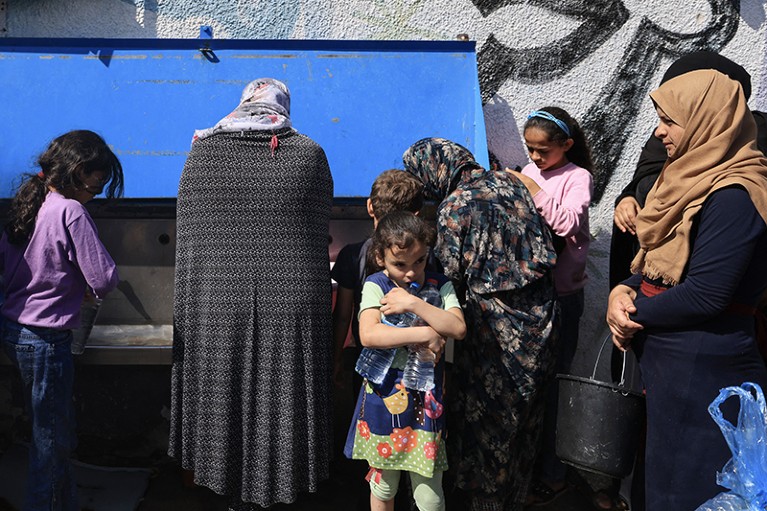
Displaced people in Gaza fetch drinking water outside a school.Credit: MAHMUD HAMS/AFP via Getty Images
Such was the case in Syria, where discontent over the government’s handling of a prolonged drought period contributed to uprisings in 2011. This spiralled into a devastating internal war that persists to this day.
Yet, perhaps counter-intuitively, as climate extremes become less anomalous and people become accustomed to more frequent water disasters, it’s possible that the number of water-related conflicts will decline, although the severity of such clashes could intensify.
That’s what Marc Müller, a water engineer at the Swiss Federal Institute for Aquatic Science and Technology in Dübendorf, and his colleagues found when they modelled the relationship between climate variability and conflict. Because the reference point for ‘normal’ levels of water availability changes, they concluded, so will the threshold at which people are willing to fight4.
Water-related conflicts could therefore become fewer and further between. But when they do arise over ever-shrinking water supplies, Müller warns, the hostilities are likely to escalate quickly. “Conflicts will be less often, but worse,” he says.
Such predictions offer little consolation to the people of Gaza, who continue to endure shortages of clean water and a sanitation crisis that is facilitating the spread of waterborne diseases.
Water challenges are nothing new in the region. Even before the current conflict, extreme overuse of groundwater resources, a lack of large-scale desalination plants and the discharge of mostly untreated sewage all contributed to water scarcities in Gaza. But the situation is now much worse — and with the world’s attention focused on the water crisis, some researchers are hopeful that more will be done to address the problem once the war ends.
“There’s going to be a lot of rebuilding necessary after all the destruction,” says David Katz, a water-policy researcher at the University of Haifa, Israel, “and maybe investing in water infrastructure will be something that can galvanize the global community.”
As Katz points out, water cooperation helped to pave the way for a peace agreement between Israel and Jordan nearly 30 years ago, and he’s hopeful that the same might be possible in any future détente between the Israeli and Palestinian governments. “Political change opens up new opportunities,” he says. “It could conceivably happen.”
Meanwhile, in Ukraine, the dire impact of Russia’s assaults on the nation’s water infrastructure is consistently and relentlessly worsening. This is starkly evident in the catastrophic destruction of the Kakhovka dam and hydroelectric power plant on 6 June 2023. The massive concrete structure crumbled. Trillions of litres of water gushed out, deluging areas downstream. At least 50 people died and thousands lost their homes.
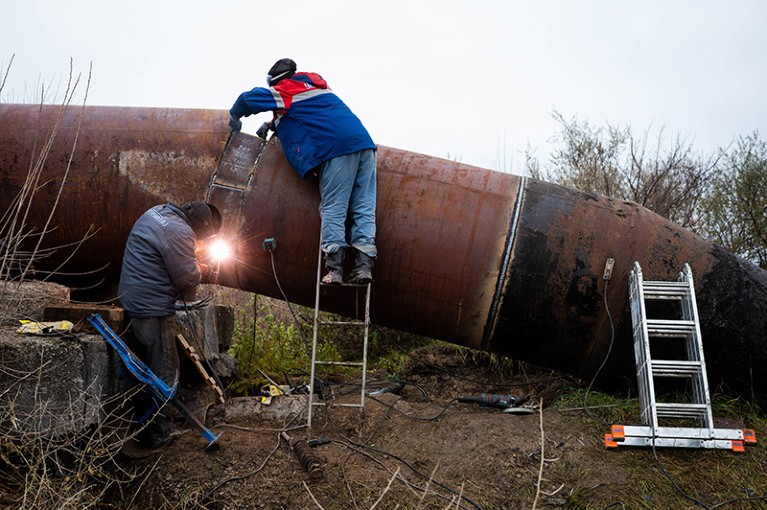
A water pipeline in Ukraine is repaired after it was damaged during the Russia–Ukraine war.Credit: Pete Kiehart/Redux/eyevine
In the intervening months, the extent of the damage to communities, agriculture and the environment has become apparent. The Black Sea, into which the flood waters and accompanying sediment poured, became polluted, with a potentially devastating impact on the local marine ecosystem. Vast tracts of flooded land are no longer amenable to farming, crippling the Ukrainian economy, and areas that remain arable will probably have reduced yields without the reservoir there to provide a steady stream of water for irrigation.
This could spell trouble for global food supplies, given the dependence by many low-income countries on Ukrainian grain. “It will touch millions of people, not only those living in Ukraine,” says Viktor Vyshnevskyi, a hydrologist at the National Aviation University in Kyiv, who has studied the myriad water-related repercussions of the dam explosion5.
This human-caused flood was not without precedent. During the Second World War, in August 1941, the retreating Soviet army destroyed a dam at the northern end of the same reservoir where the Kakhovka dam was later constructed. The goal was to slow the advance of German forces. But the obliteration of the dam resulted in massive downstream flooding that reportedly claimed the lives of thousands of people. The occupying German forces partially restored the hydrotechnical structure, before they too demolished it as the tide of the war shifted back in favour of the Soviets.
With history as a sobering backdrop — in Ukraine and beyond — the persistent use of water as both a casualty and a weapon of war remains a looming threat in a world grappling with the chaos of climate change. However, by shedding light on this issue, water scientists aspire to catalyse efforts that can avert future conflicts and ensure the protection of this invaluable resource for generations to come.
“We want to provide a resource for other researchers, policy makers and those who can enact solutions around how to prevent violent conflict related to water,” says Shimabuku.
“Could there possibly be water-resource management approaches or governance structures that can be put in place to reduce the potential harm that these conflicts drive?” she asks. In a world in which water is both a source of life and strife, the choice between conflict and cooperation will determine our shared future.

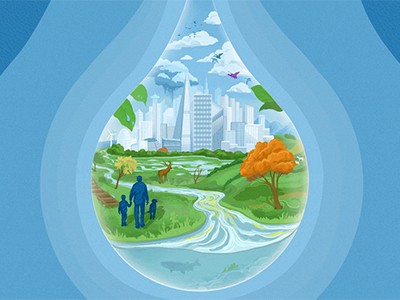
 Water: a source of life and strife
Water: a source of life and strife
 The most important issue about water is not supply, but how it is used
The most important issue about water is not supply, but how it is used
 Fresh water from thin air
Fresh water from thin air
 How to take ‘forever’ out of forever chemicals
How to take ‘forever’ out of forever chemicals
 The human factor in water disasters
The human factor in water disasters
 Sizing up hydrogen’s hydrological footprint
Sizing up hydrogen’s hydrological footprint
 Webcast: How water researchers are rethinking the global flood crisis
Webcast: How water researchers are rethinking the global flood crisis








